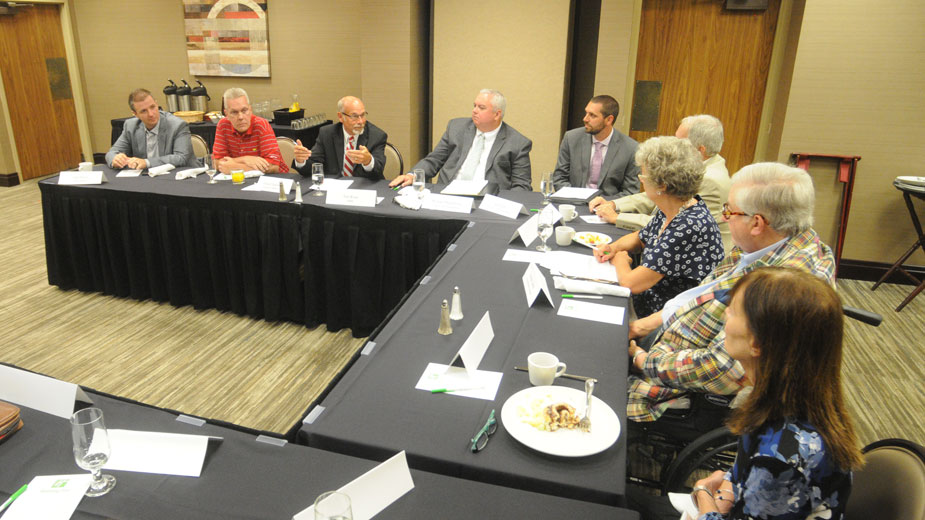To Understand Tax Law, Education is a Must: Roundtable
BOARDMAN, Ohio – Accountants knew that tax filings under the Tax Cuts and Jobs Act of 2017 would be different than many had ever seen before. Preparing for it meant plenty of reading, listening and reading again – often repeated several times throughout 2018 – for area accountants.
“It’s just the most comprehensive tax update in 30 years,” said Joe Gabriel, principal at Packer Thomas in Canfield, with a laugh. “It was about educating the staff, educating ourselves and educating our clients. It was about setting expectations. A lot of people read things and think, ‘We’re going to get this much back because of this deduction.’ It was a constant education.”
Gabriel’s observations were echoed by his colleagues at The Business Journal’s roundtable on tax reform, held July 23. An edited transcript of the discussion will appear in the MidAugust edition of The Business Journal.
Also participating in the roundtable were Marc Mazzella, tax director, Cohen & Co.; Jim Rosa, principal, tax advisory group at HBK CPAs & Consultants; Michael Humphries, president, Colella & Humphries; Daniel Wolfe, principal, Byler, Wolfe, Lutsch & Kampfer; Sam Fries, tax manager, SSB Inc.; Tim Petrey, managing member, H.D. Davis; Don Augenstein of Augenstein, Mapes & Co.; and Don Smith, executive director, Regional Income Tax Agency.
“We spent a lot of time educating ourselves on the changes. There’s a lot of training and continuing education we go through,” Humphries said. “We worked closely with our software vendor. We had to deal with not only law changes, but a major overhaul this year to tax forms in our software. We had to make sure all these laws flow through those new forms.”
For businesses, the biggest changes centered on Section 199A deductions, which affect the owners of pass-through entities such as S corporations, partnerships and proprietorships. The Tax Cuts and Jobs Act establishes a 20% deduction for certain businesses within that category.
“There are a lot of rules on how that applies at certain income levels,” Rosa said. “They get that 20% deduction if their income is higher and you have to know what wages are, what properties are used in the business and, from one profession to another, it may apply in different ways.”
The work to understand that aspect of the law alone, added Mazzella, took up a lot of time and required plenty of continuing education on the part of CPAs.
“It was intended to put pass-through entities … on the same footing as C corporations that have tax-rate cuts because of the law,” he said. “The complexity of the deduction and how it was calculated was enormous. [It] required a lot of regulations and instructions to be put out.”
Also affecting businesses, Wolfe continued, were changes to itemized deductions. The new tax code, the most changes to the law since 1986, reduced or eliminated many such deductions, including charitable contributions and unreimbursed employee expenses.
“The standard deduction increased substantially, so many people didn’t have the capability of itemizing deductions this year. Some individuals that may have had that based on past numbers couldn’t,” he said. “I had salesmen who put 60,000 miles a year on their car. That was a $30,000 deduction that was previously itemized. They did away with the 2% minimum miscellaneous deduction, which mileage falls into as a business expense.”
With all of the changes, communication with clients remains a top priority, roundtable participants agreed. At SSB, Fries noted the accountants there worked with clients throughout 2018 to prepare them for the first year of the new tax law.
“We had the entire season to let them know what’s coming. We did all their returns based on the previous law and then had time to let them know what was going to change,” Fries said. “Throughout the summer and fall, we sat down with them and saw how their year’s going so we could figure everything out. That way, they weren’t surprised when everything’s done the following year.”
And while there were substantial changes to how taxes were prepared earlier this year – all at the roundtable pointed to changes in the forms, which had been standardized for decades – the 2020 tax season should be much smoother.
“Now that we’ve seen that and done our best at planning the first go-round, the second year will give us the ability to plan even better. We’ve seen the way the forms work,” Mazzella said. “We’re understanding the additional IRS guidance on how deductibles work. We should be able to sit down and spend more time taking advantage of those rules.”
The accountants are still awaiting guidance on certain tax rules – such as on depreciation for commercial properties – but what looms largest on the horizon is the 2020 presidential election. Currently, the Tax Cuts and Jobs Act is set to be in place through 2025. That could change if a Democrat takes the White House next year, they agreed.
“If you have a change in 2020, there’s a good chance this tax law we’re still digesting might change in 2021,” Gabriel said. “You want to be able to talk to your client and look three, four, five years down the line. But the way it is from a political standpoint, you really can’t do that.”
Pictured: Area accountants joined The Business Journal for a roundtable discussion on the effects of the Tax Cuts and Jobs Act. An edited transcript of the talk will appear in our MidAugust issue.
Copyright 2024 The Business Journal, Youngstown, Ohio.



